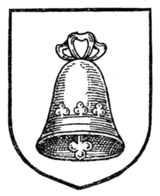being shorter and more pointed. The scymitar follows the form depicted in Fig. 516.
A Seax is the term employed to denote a curved scimitar, or falchion, having a notch at the back of the blade (Fig. 517). In heraldry the use of this last is fairly frequent, though generally, it must be added, in shields of arms of doubtful authority. As such they are to be seen, amongst others, in the reputed arms of Middlesex, and owing to this origin they were included in the grant of arms to the town of Ealing. The sabre and the cutlass when so blazoned follow their utilitarian patterns.
Torches or Firebrands are depicted in the arms and crest of Gillman and Tyson.
Barnacles (or Breys)—horse curbs—occur in some of the earlier coats, as in the arms of Wyatt ["Gules, a barnacle argent"], while another family of the same name (or, possibly, Wyot) bore: "Per fess gules and azure (one or) three barnacles argent"].
 Fig. 516.—Scymitar. |
 Fig. 517.—Seax. |
 Fig. 518.—Church-bell. |
 Fig. 519.—Hawk's bell. |
Bells are well instanced in the shield of Porter, and the poet Wordsworth bore: "Argent, three bells azure." It may be noted in passing that in Continental armory the clapper is frequently of a different tincture to that of the bell, as, for instance, "D'Azure, à la cloche d'argent, butaillé [viz. with the clapper] de sable"—the arms of the Comtes de Bellegarse. A bell is assumed to be a church-bell (Fig. 518) unless blazoned as a hawk's bell (Fig. 519).
Bridle-Bits are of very infrequent use, though they may be seen in the achievement of the family of Milner.
The Torse (or wreath surmounting the helm) occasionally figures as a charge, for example, in the arms of Jocelyn and Joslin.
The Buckle is a charge which is of much more general use than some of the foregoing. It appears very frequently both in English
